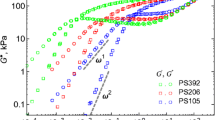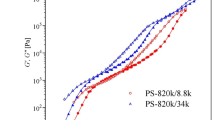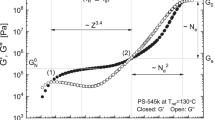Abstract
Nonlinear shear and uniaxial extensional measurements on a series of graft-polystyrenes with varying average numbers and molar masses of grafted side chains are presented. Step-strain measurements are performed to evaluate the damping functions of the melts in shear. The damping functions show a decreasing dependence on strain with an increase in mass fraction of grafted side chains. Extensional viscosities of the melts of graft-polystyrenes exhibit a growing strain hardening with increasing average number of grafted side chains as long as the side branches have a sufficient molar mass to be entangled. Graft-polystyrenes with side arms below the critical molar mass M c for entanglements of linear polystyrene but above the entanglement molar mass M e of linear polystyrene (M e < M w,br < M c) still show a distinct strain hardening. With decreasing molar mass of the grafted side chains (M w,br < M e) the nonlinear-viscoelastic properties of the graft-polystyrene melts approach the behavior for a linear polystyrene with comparable polydispersity.












Similar content being viewed by others

References
Doi M, Edwards SF (1986) The theory of polymer dynamics. Clarendon Press, Oxford
Ferri D, Lomellini PJ (1999) Melt rheology of randomly branched polystyrenes. J Rheol 43:1355–1372
Ferry JD (1980) Viscoelastic properties of polymers. Wiley, New York
Gabriel C, Münstedt H (1999) Creep recovery behavior of metallocene linear low-density polyethylenes. Rheol Acta 38:393–403
Gotsis AD, Zeevenhoven BLF, Tsenoglou C (2004) Effect of long branches on the rheology of polyproylene. J Rheol 48:895–914
Grigo U, Kircher K, Müller PR (1996) Polycarbonates. In: Bottenbruch L (ed) Engineering thermoplastics: polycarbonates, polyacetals, polyesters, cellulose esters. Carl Hanser Verlag, Munich
Haug PK (2000) Polystyrol-Pfropfpolymere definierter Struktur als Modellsystem für Langkettenverzweigungen in Polyolefinen. Doctoral Thesis, University of Stuttgart
Heino EL, Lehtinen A, Tanner J, Seppälä J (1992) Theoretical and Applied Rheology. In: Proceedings of the XIth international congress on rheology, pp 360–362
Hepperle J (2003) Einfluss der molekularen Struktur auf rheologische Eigenschaften von Polystyrol- und Polycarbonatschmelzen. Doctoral Thesis, University Erlangen-Nürnberg
Hepperle J, Münstedt H, Haug PK, Eisenbach CD (2005) Rheological properties of branched polystyrenes—linear viscoelastic behavior. Rheol Acta (in print)
Hingmann R, Marczinke BL (1994) Shear and elongational flow properties of polypropylene melts. J Rheol 38:573–587
Khan SA, Prud’homme RK, Larson RG (1987) Comparison of the rheology of polymer melts in shear, and biaxial and uniaxial extensions. Rheol Acta 26:144–151
Kurzbeck, S (1999) Dehnrheologische Eigenschaften von Polyolefinschmelzen und Korrelationen mit ihrem Verarbeitungsverhalten beim Folienblasen und Thermoformen, Doctoral thesis, University Erlangen-Nürnberg
Kurzbeck S, Oster F, Münstedt H, Nguyen TQ, Gensler RJ (1999) Rheological properties of two polypropylenes with different molecular structure. J Rheol 43:359–374
Larson RG (1985) Nonlinear shear relaxation modulus for a linear low-density polyethylene. J Rheol 29:823–831
McLeish TCB, Allgaier J, Bick DK, Bishko G, Biswas P, Blackwell R, Blottière B, Clarke N, Gibbs B, Groves DJ, Hakiki A, Heenan RK, Johnson JM, Kant R, Read DJ, Young RN (1999) Dynamics of entangled H-polymers: theory, rheology, and neutron-scattering. Macromolecules 32:6734–6758
Münstedt H (1979) New universal extensional rheometer for polymer melts. Measurements on a polystyrene sample. J Rheol 23:421–436
Münstedt H (1980) Dependence of the elongational behavior of polystyrene melts on molecular weight and molecular weight distribution. J Rheol 24:847–867
Münstedt H, Laun HM (1981) Elongational properties and molecular structure of polyethylene melts. Rheol Acta 20:211–221
Papanastasiou AC, Scriven LE, Macosko CW (1983) An integral constitutive equation for mixed flows: viscoelastic characterization. J Rheol 27:387–410
Pearson DS, Mueller SJ, Fetters LJ, Hadjichristidis N (1983) Comparison of the rheological properties of linear and star-branched polyisoprenes in shear and elongational flows. J Polym Sci Polym Phys Ed 21:2287–2298
Soskey PR, Winter HH (1984) Large step shear strain experiments with parallel-disk rotational rheometers. J Rheol 28:625–645
Takahashi M, Isaki T, Takigawa T, Masuda T (1993) Measurement of biaxial and uniaxial extensional flow behavior of polymer melts at constant strain rates. J Rheol 37:827–846
Wagner MH (1976) Analysis of time-dependent non-linear stress-growth data for shear and elongational flow of a low-density branched polyethylene melt. Rheol Acta 17:136–142
Wagner MH (1979) Zur Netzwerktheorie von Polymer-Schmelzen. Rheol Acta 18:33–50
Wagner MH, Laun HM (1978) Nonlinear shear creep and constrained elastic recovery of a LDPE melt. Rheol Acta 17:138–148
Wagner MH, Bastian H, Hachmann P, Meissner J, Kurzbeck S, Münstedt H, Langouche F (2000) The strain-hardening behaviour of linear and long-chain-branched polyolefin melts in extensional flows. Rheol Acta 39:97–109
Acknowledgements
Financial support from the German Research Foundation (DFG) (grant numbers Mu 1336/2-1 and Mu 1336/2-3) is gratefully acknowledged. J.H. wants to thank Prof. Dr. M. H. Wagner for the source code of the program for the damping function calculations.
Author information
Authors and Affiliations
Corresponding author
Electronic supplementary material
Rights and permissions
About this article
Cite this article
Hepperle, J., Münstedt, H. Rheological properties of branched polystyrenes: nonlinear shear and extensional behavior. Rheol Acta 45, 717–727 (2006). https://doi.org/10.1007/s00397-005-0031-9
Received:
Accepted:
Published:
Issue Date:
DOI: https://doi.org/10.1007/s00397-005-0031-9



